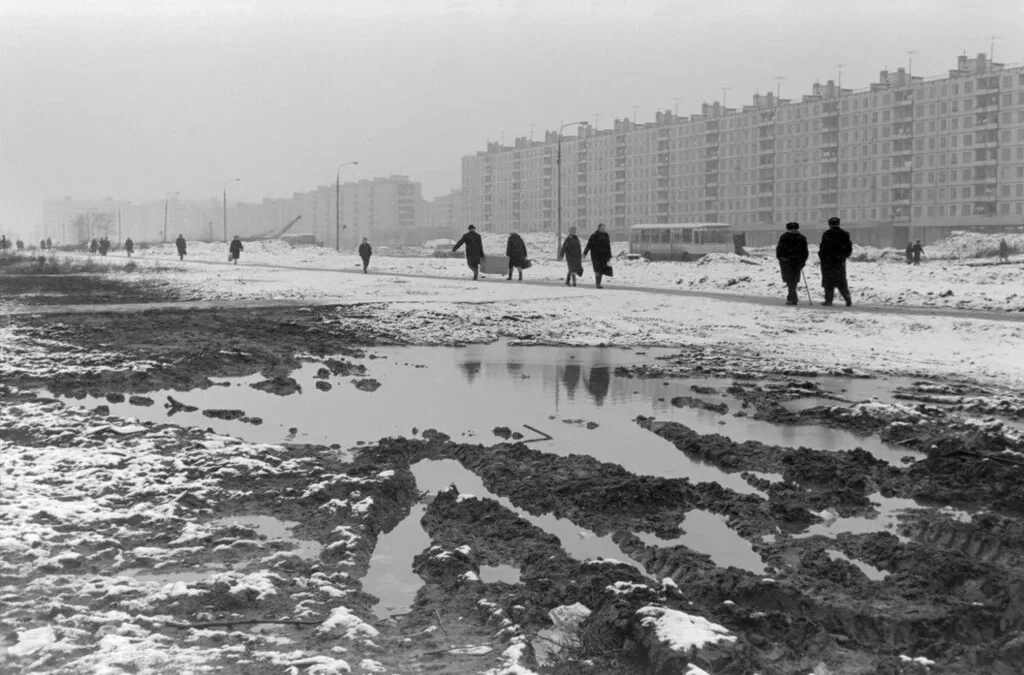Written by SUSK Canada Summer Job Intern – Daniil Zhelezniak (Saint Mary’s University)
Introduction
In the modern Western world, there is a myth that is very actively spreading and is readily picked up by a part of society that life under socialism and its radical version of communism can not only be as good as it is now, but even better. However, such rosy ideas about this leftist ideology, universal equality, justice, and sustainability are far from reality, as Ukrainians and dozens of other nations living under this regime are well aware of. This article debunks the myths about life in Ukraine, one of the 15 republics of the USSR, examining the grim realities of that time through the analysis of statistics, facts , and comparing with the most advanced countries of that era. It is based on the daily life of an ordinary person in the Ukrainian Soviet Socialist Republic, especially in such medium–sized regional centers in the not-so-terrible 1960s and 1970s, for a fair experiment.
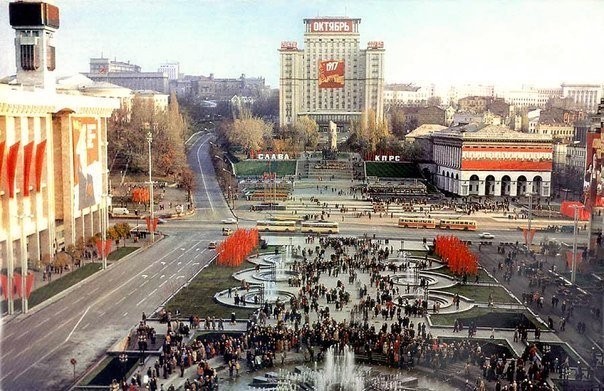
Kyiv, Kalinin Square (now Independence Square) – the central city square in Soviet times
A brief context
Communism, like fascism, is among the most aggressive socio-political and economic movements, but if most people reject fascism because of the horrors of World War II and modern globalization, then radical leftist ideas are more insidious. The currents of socialism often not only do not cause negative emotions, but on the contrary find the key to new hearts, especially among young people. Economic and socio-political crises, rising prices, inequality, and the rise of right-wing populism are pushing people in developed countries toward ideological shifts. As a result, many begin to admire the ideas of a strong state, common ownership, classlessness (total equality), and a sense of historical justice. According to well-known data, 62% of residents of the most powerful Western capitalist country, the US, aged 18 to 29, have a positive attitude towards “socialism”, and even 34% have a positive attitude towards “communism” (Coopwood, 2025). Similar trends are observed across the West, with support for socialism among young people aged 18–34 reaching 46% in Canada, 50% in Australia, and 53% in the United Kingdom (Clemens & Globerman, 2023, pp.1-2). To interpret these polls another way, dissatisfaction with the current capitalist system is even clearer—72% of Canadians and 66% of Americans support a wealth tax, particularly higher taxes on the rich, but oppose tax hikes affecting themselves (Clemens & Globerman, 2023, pp. 2-3).
Everyday Life and Deficit
Deficit: The Soviet Union, being a communist society, had a planned economy where there were no market mechanisms, no balancing supply and demand, besides investing resources in heavy industry and weapons, and neglected consumer goods and agriculture (Kromf, 2022). Due to the lack of communication and gaps between the demand from the population and what the state could provide, in the USSR, the word “deficit” became a part of the everyday vocabulary since almost its entire existence. Even in Nikita Khrushchev’s time, when the situation was better with the rapid growth of the economy, the list of scarce products included almost everything from meat, cheese and sausage to clothes, shoes, soap, contraceptives, and furniture (Sherrin, 2022). As a result, ordinary people faced a “commodity famine”: poorly stocked shops and kilometer-long queues for basic necessities, like boots or sugar, were the norm (Ancheta, 2023). The empty shelves and rationing of products of those years in the largest and richest country in resources and arable fields can be compared to modern Cuba for understanding, which contrasted sharply with the abundance observed in Western supermarkets (Noguero, 2025). Another feature is that in the 1960s and 70s, the distribution system was so unstable and primitive that even if goods were available, they often did not reach consumers. In addition, there was a big difference in the supply and its diversity between the key centers of the country, such as Moscow, Leningrad, Riga, or Kyiv, and the so-called periphery, such as Mykolaiv or Sumy in Ukraine (Bahry & Nechemias, 1981, pp. 369-371). In the 1970s, real per capita consumption in the USSR was only a third of that in the United States, given the low quality of goods, limited assortment, and uneven distribution by region (Edwards, Hughes, & Noren, 1981).
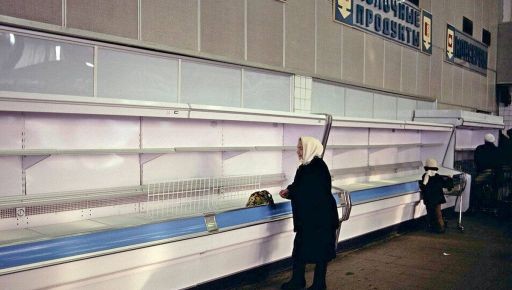
Empty shelves in stores are a characteristic feature of the Soviet era
Corruption: This state of affairs has led to nepotism and bribery (the infamous “blat” system) which became tools of survival. In fact, to get things, people had to know the right people, and for example, familiarity with sellers or warehouse managers was considered elite. Ordinary people created complex informal networks and combinations of services and barter to purchase goods – in fact, a parallel black market economy. Sometimes store managers would secretly sell coveted goods “from the back door” to friends and relatives even before they hit the shelves, which was very ineffective for the economy (Treml & Alexeev, 1993, pp.23-26). It was not unusual for a rare supply to be completely snapped up by those who had access to insider information, while the general public did not even notice it. The Soviet press and government condemned this practice from time to time, but it was the logical result of a system in which money alone often could not buy the most necessary things – a “blat” or exchange was required (Schwartz, 1979, pp. 437-438). This corruption was even officially recognized: by the 1970s, a significant proportion of Soviet trade was carried out by special allocation for privileged segments of the population, which will be discussed later (Treml & Alexeev, 1993, pp.6-9). However, for the average Ukrainian family, daily life meant constant queues, a battle for their place in the sun, intrigues and improvised means to cope with the endless shortage of everything.
Diet and Food: Despite the fertile soil of Ukraine, food supplies were unstable and extremely scarce, both in variety and quality, but even this is better than the situation in the 30s, when a terrible famine struck some parts of the country, including Ukraine (Holodomor). In the post-war decades in Soviet Ukraine, state-owned stores sold basic products such as coarse black bread, potatoes, and seasonal cabbage. It happened since they were considered more economical and easier to produce, but higher-quality products were in short supply, especially outside major cities (Hannah, 2023). Meat and sausages were usually not enough, as well as products such as butter, the lowest quality coffee and tea or fresh fruits, so many people saw tangerines from Georgia only on New Year’s Eve (Kulzhenko, 2024). Customers often saw only one type of canned fish or one type of low-quality sausage on the shelves, which did not provide a rich, healthy diet with the necessary and diverse amount of vitamins and proteins (Olson, 1960, pp. 2-8). In the 1960s and 70s, although the caloric content of the Soviet people’s diet was about the same as in the United States, however, most of these calories and proteins came from bread, potatoes, sometimes eggs and milk, and not in meat as in the US (Masterovoy, 2013, p.65-66). Since restaurants were often extremely inaccessible to the working class, people ate in canteens (buffets) or cooked at home from products they could find and afford, so very often the original recipes were transformed into more affordable ones, which required ingenuity. The most popular dishes on the tables of Ukrainians of those years were: soups (red and green borscht, rosoljnyk, solyanka), pelmeni and varenyky (dumplings), dolma or holubtsi (stuffed cabbage rolls), diverse pirozhki (pastry), pickled vegetables, salted herring, and porridge (Weida, 2024). Alcohol consumption was still mostly limited to vodka, although Ukraine was a major wine producer and all alcohol was usually consumed heavily rather than gradually (Rohanska, 2024). This pattern eventually made the USSR one of the record holders for alcoholism, which led to the destruction of alcohol production in Ukraine a decade later (1980s).
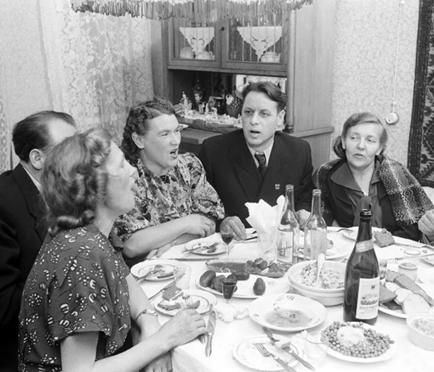
Feasts in the 1960s in Soviet Ukraine
Everyday Goods as Luxuries: Another aspect of the communist system is that ordinary, everyday items were considered luxury items and were often unavailable for various reasons. For example, the Soviets launched people into space and built rockets, but toilet paper practically did not exist for the population until the end of the 1960s – the first Soviet toilet paper factory was built only in 1969 (Tsernov, 2022). Other everyday items were used in a similar way: plastic shopping bags were reused and stored as valuables, ballpoint pens had to be smuggled or refilled by specialists, and basic household appliances were difficult to find. Even ordinary books and novels were difficult to buy – there was practically nothing in Soviet bookstores except political propaganda, which forced people to turn to libraries or friends for literature (“Glavlit censorship: Banned in the Soviet Union”, 2024).
Housing, Living Conditions and Work
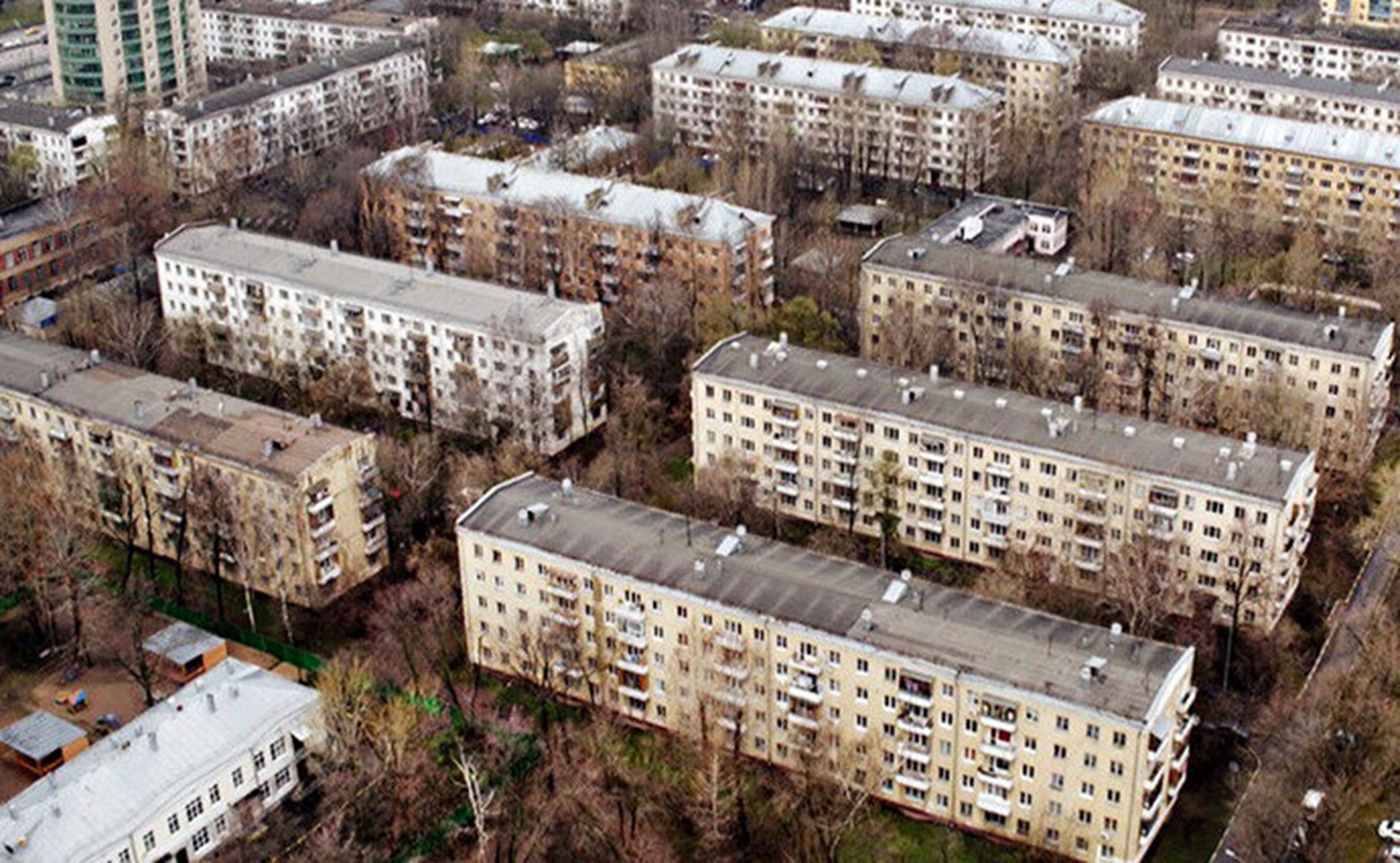
Khrushchevka – typical buildings from the time of Khrushchev’s rule
Housing shortage: One of the most famous and proud Soviet statements was that everyone received “free housing” from the state – unlike workers in the capitalist West, who had to pay off mortgages or save for a long time. The reality was much darker, although the apartments were nominally free, in reality, very few were available (Kromf, 2022). Most young families had to wait in line for years or even decades to receive their flat from the authorities while living in a communal apartment (which they shared with other families) or with their parents before getting a separate apartment. Due to economic problems and the planned system, the state simply could not provide everyone with individual housing. By the early 1960s, about half of urban Soviet families, including in Ukraine, were still living in overcrowded communal homes or dormitories (Morton, 1985, p.61). The phenomenon of “communal apartments” arose under Lenin and Stalin as a utopian attempt to collectivize everyday life and “wean citizens from bourgeois privacy,” forcing people to live collectively and supposedly be responsible for each other. Later, under Khrushchev, a massive campaign of construction of prefabricated apartment buildings (the famous “Khrushchevka”) improved the situation somewhat. Families who moved from communal housing to a tiny 2-room Khrushchevka – 400-500 square feet (with its own kitchen and bathroom), often perceived it as one of the main achievements in life, despite paper-thin walls and substandard construction. The rigid housing system has also given rise to corruption here — bribes and unofficial “apartment exchanges” have become commonplace (Feldbrugge, 1984, pp.535-540). For example, a family in Chernihiv can exchange their smaller apartment for an apartment in Sumy for a small payment, favor, or rare good, combining several moves from one city to another to eventually get to the desired location, which only highlights the inefficiency. Officials in charge of housing construction could be persuaded to move someone on the waiting list higher up the list or offer a more profitable apartment, which created an illegal shadow exchange market that often covered a region or several cities. In addition, this state of affairs created dependence on the state, which was deliberate; it limited mobility and forced people to be beholden to the system.
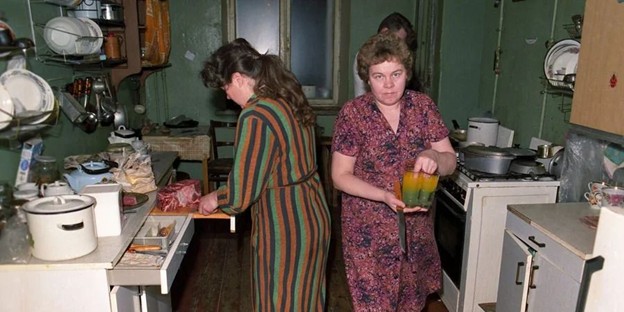
Standard Soviet cuisine in the 1970s
Personal Possessions: The total deficit and the consequence of general poverty were expressed in other ways, in particular in car ownership. By 1975, the ratio of cars per person in the USSR was only 1 car per 54 people, compared with about 1 per 2 people in the USA (had almost the same population), and the decade before that, the gap was even bigger (Hunter, 1966, pp.64-65). In other words, only about 2% of residents of the Soviet Union owned a car, and often, as with apartments, the queues for low-quality cars were long, which severely limited mobility and created dependence on government services. Ground-based public transport (buses, trams) was very popular, and in small towns it was often crowded and infrequent, however, for example, aviation was more developed than it is now, serving small cities like Berdiansk or Izmail. Household appliances were not widespread; a TV or refrigerator was a big purchase for which families saved money and then stood in line, while dishwashers and microwaves were completely absent. Even by the end of the 1970s, owning all the basic household appliances–a refrigerator, washing machine, TV, and possibly a vacuum cleaner–was relatively rare (“Production of large appliances in the U.S. and Soviet Union 1970-1987”, 1991).
Work and salary: Soviet citizens had guaranteed employment – the state promised full employment and there were penalties for parasitism. However, this often meant hidden underemployment and low productivity. Wages were modest and, due to government policy, they were equalized: an engineer at a factory in the 1970s could earn about 150 rubles a month, and a cleaner could earn about 70 rubles. Specialists (doctors, teachers) earned little more than laborers, who were heavily supported at the time, which greatly demotivated people from studying or trying to advance their careers. While utilities and bread were subsidized, consumer goods, if available, were expensive compared to salaries. A TV could cost several monthly salaries, a new Soviet-made car (for example, a Zhiguli/Lada) officially cost about 5000-10000 rubles (salary for many years) (Lanin, 2019). However, such large purchases were often possible only for those who had an unofficial income (black market transactions, part-time work in the private sector) or held high positions in the nomenclature hierarchy.
In general, the Soviet economic model failed to provide a comfortable life at all, and the real standard of living in the USSR was much lower than in the West. In 1976, a comprehensive study showed that per capita consumption in the USSR was only about 34% of the level in the United States, and even this figure was generous for the USSR, given the “notoriously low quality and narrow range” of goods and services available (Edwards, Hughes & Noren, 1981, pp.4-5). In particular, in the Soviet Union, living space per person was only about one-seventh of the U.S. level, and consumer durables (cars, household appliances) accounted for less than 20% of the U.S. level. Roughly speaking, the average family in capitalist countries such as Canada, Japan, West Germany, or the United States enjoyed much higher comfort, a greater variety of food, better housing, and greater household amenities in the 1960s and 70s than their counterparts in Soviet Ukraine, one of the richest Soviet republics. The “Socialist paradise” was significantly behind even some other communist countries in material terms – for example, East Germany, Yugoslavia, or Czechoslovakia often had a higher standard of living and a greater variety of goods (Hussain, n.d.). Ordinary Soviet citizens might not have known the exact statistics, but they intuitively understood their difficulties and that this could not be the norm, which increased discontent.
Political Repression and Loss of Freedoms
If everyday life was difficult from an economic point of view, then perhaps it was even more oppressive from the point of view of personal freedoms and the protection of citizens. The Soviet system required conformity and obedience; dissent or deviations from the norm could be severely punished. Political repression in the post-Stalin 1960s and 70s took on less bloody, but more cunning forms than mass executions or labor camps during the Stalinist terror, but, nevertheless, they were widespread. Ukrainians, like other Soviet citizens, lived under a cloak of fear that affected speech, language, culture, displacement, and even privacy.

Surveillance: Soviet law enforcement agencies (primarily the KGB) closely monitored society and tracked any changes. There was an extensive network of informers (stukachi) – ordinary people who were forced or stimulated to rat on their neighbors, work colleagues, or even friends and relatives. The result was an atmosphere of distrust in which one had to be careful about what to say and to whom. A casual joke criticizing the party and the leaders or a cynical remark about the leadership could get you into very serious trouble. If in Stalin’s time a joke could mean 10 years in a GULAG or even worse, under Khrushchev and Brezhnev the punishments were somewhat less draconian, but still real, since there were laws against “anti-Soviet agitation and propaganda” (Dresser, 2019). Moreover, failure to report an anti-Soviet joke or comment to the authorities was in itself a crime and could result in up to 5 years in prison for “failure to report” (“ARTICLE 62 OF THE UkrSSR CRIMINAL CODE ANTI-SOVIET AGITATION AND PROPAGANDA”, n.d.). People learned to control themselves tightly; criticizing the government was safe only in a company they trusted (and even then, many preferred to remain silent). By the 1970s, the KGB’s network of informants had spread to factories, universities, and apartment buildings, including rural areas (Hornsby, 2025). It would not be an exaggeration to say that the authorities were eager to know everything: who said what, who read what, who met with whom.
Censorship: The government also strictly controlled the media, literature, and art to prevent any criticism or “unapproved” ideas. All newspapers, radio, and later television were controlled by the state and were full of propaganda, and foreign media and culture were banned. Some well–known authors, such as Vasyl Stus, Ivan Dziuba, Vasyl Simonenko, Ivan Svitlychnyi, Boris Pasternak, and Alexander Solzhenitsyn, were punished as anti-Soviets, and possession of their works could lead to interrogation by the KGB (Savchyn, 2021, pp.241-242). Moreover, in Ukraine, the works of local writers who wrote about forbidden truths (such as the Holodomor or the Ukrainian independence movement) were, of course, strictly prohibited and severely punished. An illustrative example is the Ukrainian poet Lina Kostenko, who was blacklisted in 1970s and could not publish her poems for years (Nahaylo, 2025). Cinema was the same, as the famous film director Sergei Parajanov was banned from making films and later imprisoned on trumped-up charges because his artistic vision did not correspond to Soviet ideas (Kozlenko, 2025).

“Today you play jazz, tomorrow you’ll sell out the Motherland.” A Cold War slogan warning that enjoying Western culture (like jazz) leads to political betrayal. It shows Soviet propaganda and fear of Western influence.
Besides that, under Leonid Brezhnev, the regime not only targeted outspoken dissidents, but crackdown extended to “harmful elements” such as hippies, homosexuals, underground religious believers, and fans of Western fashion—youth with long hair or rock styles drew surveillance and harassment from authorities (Miano, 2025). Blue jeans, while not officially banned, became a symbol of Western rebellion; while importing was criminalized under charges like “speculation,” offenders risked imprisonment for involvement in the black‑market trade.
Suppression of protests: Open protests against the Government were extremely rare and were met with the immediate use of force, often violent. The Soviet propaganda machine liked to portray Soviet society as monolithically satisfied, but discontent did exist, especially when living conditions became unbearable. One striking example was the 1962 uprising in Novocherkassk, in Ukraine’s neighboring Rostov Region, where workers went on strike and demonstrated in protest after a sudden sharp increase in state-controlled food prices combined with wage cuts at the factory. Moscow’s reaction was swift and ruthless: troops were deployed and opened fire on the unarmed justice-seeking crowd, killing at least 23 protesters (Ivanova, 2021). The incident was then hushed up for decades, and the Novocherkassk case serves as a stark reminder that even under the “reformist” leader Khrushchev, the communist regime would rather kill its own workers than tolerate dissent. There were no protests of this magnitude in Ukraine at that time (perhaps the memory of Stalin’s terror was still too fresh), but small riots and strikes did take place and were suppressed in a similar way. During the Brezhnev era, the KGB prevented any organized protest, whether it was students or workers advocating for human rights, in other words no anti-government protests were simply allowed.
Tourism: Under the Soviet regime, traveling abroad behind the Iron Curtain was quite difficult for ordinary citizens because it required an exit visa and permits approved by the KGB, of course, unless you were a trusted member of the Communist Party, a successful and loyal worker or a representative of the elite. Tourism to capitalist countries such as Western Europe was on the verge of fantasy; even trips within the socialist Eastern Bloc (Poland, Czechoslovakia, Hungary, the GDR, and so on) required official tours (often conducted by an “Intourist”) (Tondera, 2014, pp.26-29). Tourists were subjected to strict itinerary schedules and constant surveillance, so that no one saw anything that went beyond the state’s understanding of Soviet life. Internal mobility was also tightly controlled by the closure regime of certain regions and the registration system (the propiska), so, until the mid‑1970s, many rural residents did not have internal passports and did not have the legal right to move to cities (Höjdestrand, 2003). They remained virtually tied to their native villages, while urban residents needed an official residence permit to live or work in another city.
Inequality, Privilege, and Corruption
Communist ideology preached total equality and fraternity, but in fact, Soviet society had a clearly defined class system: the privileged elite (party and government nomenclature) enjoyed advantages far beyond the capabilities of the average citizen. While the workers were told that they were the masters of the state, in reality, it was a small ruling class that lived in relative luxury. This blatant hypocrisy is one of the greatest underestimated truths about life in the “egalitarian” USSR, about which romanticized myths have been created.

The elite of the USSR including Leonid Brezhnev on a yacht in the Black Sea
Privileges of the Soviet elite: Top party officials, bureaucrats, and privileged professionals (such as leading scientists, military officers, or famous artists) made up the unofficial aristocracy. They had access to special closed shops and distribution centers where ordinary people could not access. It is well known that there were individual grocery stores where high-quality food and imported goods were available, which would never be seen in ordinary stores (Liivik, 2020). While an ordinary Ukrainian housewife could hardly find a piece of greasy sausage, the wife of the party leadership in Kyiv could buy a top-quality chop, Kamchatka crabs, Swiss cheese, tropical fruits, and even caviar. Needless to say, ordinary citizens were strictly forbidden from entering these special stores – the guards could not let you in without the necessary identification or special permission, which accumulated public discontent.
The nomenclature had access not only to excellent food but also to the exclusive “Berezka” stores, where imported luxury goods such as Western music records, electronics, and Western fashion were sold, while ordinary citizens could only look at them from empty supermarket shelves. They lived in superior homes, drove chauffeured cars, spent vacations in dachas, regularly flew to resorts in Crimea and the Caucasus and even abroad, and received elite medical care in special hospitals with access to Western medicines — benefits unavailable to the general public (Conine, 1986). This is the absolute hypocrisy of Soviet propaganda about equality.
Social Ills behind the “Stable” Façade
The Brezhnev era (mid‑1960s-early 1980s), often referred to as the “stagnation” period, was officially praised for its calm, low crime rate, and public order. However, this disguise hid a growing dysfunction: although the crime rate in the USSR remained lower than in the United States, in the 1970s it exceeded the figures of most European countries, which was partly caused by widespread alcoholism, the concealment of mental problems in society and economic frustration (Kromf, 2022). As already mentioned, alcohol abuse became widespread — spirits were cheap and always available, and by the middle of the century, their consumption had grown significantly. As a result, men’s life expectancy began to decline, dropping from about 67 years in the mid‑1960s to a low 60 years by 1980, even though the health infrastructure was not helping (Dinkel, 1985, pp. 87-89). Despite official propaganda (which is still often repeated by nostalgists) that portrayed Soviet streets as crime-free and police incorruptible, brutality, corruption, and cover-ups were common but rarely acknowledged. The authorities hid industrial accidents, environmental threats, widespread transport tragedies, or terrorist attacks. A vivid example of this is the shooting down of a Korean Boeing 747 by mistake near Sakhalin Island in 1983 (here we can draw analogies with the Malaysia Airlines Boeing shot down by the actions of the Russian Federation over Donbas in 2014) (Charles, 1991).

Transport accidents were a frequent occurrence in the USSR. The photo shows an aerial collision between a Tu-134 and An-26 near Zolochiv, Lviv Oblast, which caused 94 deaths, 1985.
Dissenting or outspoken people were often given fabricated diagnoses of mental disorders such as “sluggish schizophrenia” in order to discredit and neutralize the opposition without public trials. Crimes such as those of serial maniacs like famous Andrii Chykatylo or armed gangs were quietly buried by the regime before Perestroika, which reinforced the illusion of moral purity, while reality showed that society was struggling with violence, repression and deteriorating public health (Kromf, 2022).
Religion and Repression of Belief
The doctrine of Marxism-Leninism was officially atheistic, and the Soviet leadership was often hostile to religion. In Ukraine, which had a rich religious life before the advent of communism (Orthodox Christians, Greek Catholics, Jews, Muslims, Protestants, etc.), during the Soviet period there were serious, repressive restrictions on religious freedom. By the 1960s and 70s, open worship became possible only with strict regulation and the introduction of the aforementioned system of informers, and many religious communities were driven underground and often branded as sects. Despite the course of de-Stalinization, a particularly aggressive anti-religious campaign was conducted under Nikita Khrushchev from 1959 to 1964, during which the Soviet government closed thousands of religious buildings (Van den Bercken, 1988, pp. 114-115). Monasteries were closed, seminaries were reduced, and many clergymen were forced to leave the clergy. Of the 1,500 mosques operating in the USSR in 1959, only about 400 remained by the mid-1960s (Khrushchev closed about 1,100 of them). It also reflects the oppression of Muslim communities, including the Crimean Tatars, who were brutally deported to Central Asia under Stalin, and whom Khrushchev did not allow to return despite the transfer of Crimea to Ukraine (Bennigsen & Wimbush, 1986, p.17). However, the worst thing happened to the Ukrainian Greek Catholic Church (UGCC), which is very important for western Ukraine: in 1946 it was completely banned by Stalin, and its clergy were imprisoned (Diuk, 2016). Thus, in Lviv, Ternopil, and Ivano-Frankivsk oblasts throughout the Soviet era, Greek Catholic worship existed only in secret, underground, until legalization in 1989, which, undoubtedly, can be considered as a suppression of the Ukrainian identity. Moreover, young people were not encouraged to attend church – parents were afraid that their children would face discrimination at school or at work if it became known that they were religious. There have been cases where simply attending church could undermine career prospects, especially for party members or those in positions of responsibility. The regime promoted “scientific atheism” – ubiquitous lectures and the media ridiculed religious “superstitions” (Froese, 2004, pp.40-45). It was also difficult to own religious literature (Bibles, Korans, Torahs, etc.), since there were few religious publications, and the import of such texts was illegal. It was only by the 1970s that a kind of balance and limited truce was established – the state allowed a small number of churches to function, but under its control. The USSR prided itself on having “freedom of conscience” in its constitution, but in practice that freedom was only for those whose conscience aligned with Marxist–Leninist atheism.
The Global Cost of the Communist Experiment
The suffering experienced in Soviet Ukraine was obviously not unique—it reflected the systemic failures of communism wherever it was implemented. Across the globe, attempts to build communist societies have resulted in economic collapse, oppression of local cultures, and mass human suffering. The USSR under Stalin saw tens of millions perish through famine, mass deportations, gulags, and ethnic cleansings, Ukraine alone lost up to 4 million in the Holodomor (Ruane, 2022). Even during the “stable” years, the system jailed dissidents, crushed uprisings, in Budapest in 1958, in Prague in 1968, or Rostov Oblast in 1962, and waged wars like the invasion of Afghanistan (1979–89), which killed over a million Afghans and thousands of their troops (Cramer, 2020). In another major communist country, in China, Mao’s Great Leap Forward caused at least 45 million deaths, mostly from starvation and violent repression, and the Cultural Revolution added millions more (Branigan, 2013). In Cambodia, Pol Pot’s Khmer Rouge (1975–1979) killed roughly 1.5–3 million people, a quarter of the population, trying to create a communist agrarian utopia (Scheffer, 2025). Cuba, often idealized by the far-left, became a one-party police state with political prisoners, deep poverty, rationing, and mass emigration to the capitalist and democratic U.S. The well-known case of North Korea remains the world’s most isolated dictatorship, with famine and brutal control persisting for decades.
Overall, the death toll under communism in the 20th century is estimated at about 100 million people – this figure includes those who were killed as a result of executions, artificial starvation, labor camps, and other repressive measures (Satter, 2017). This staggering number is highly likely to exceed the number of victims of World War II and is a grim warning of what happens when extremist ideology is introduced without regard for human rights or economic realities. Romanticizing this ideology is not only wrong, but also dangerous because it ignores the lessons recorded in the blood and tears of many people on almost all continents of the Earth.
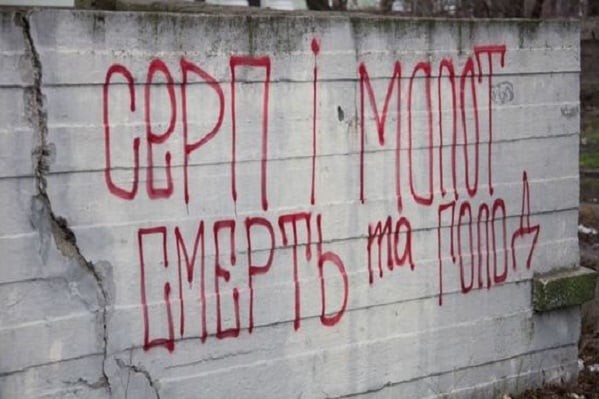
“The hammer and sickle mean death and hunger”. A modern anti-Soviet phrase. It mocks the USSR’s symbol, linking it to famine and repression instead of workers’ unity.
Conclusion
Instead of justice, equality, fraternity of peoples, and stability, Soviet communism brought the opposite: inequality and privilege for the few, oppression of freedoms and identities, control and division, and chronic instability in supply and quality of life. It was a country where they destroyed the best and most effective, the most independent and proactive, so that everyone else would be silent. The stability of the Khrushchev and Brezhnev eras was in many ways a facade – under the external calm there were systemic dysfunctions that eventually led to the complete collapse of the system in 1991. People who dream of equality, cheap bread, or guaranteed employment often gloss over shortages, lack of freedom, fear of the KGB knocking on the door, and the complete lack of consumer amenities typical of that era. For the Ukrainian diaspora in Canada and other countries, these truths are often part of family stories – many emigrated (or their relatives did) precisely because they sought various freedoms or were fleeing persecution. They can witness how communism tried to destroy the Ukrainian language and culture (branding any local patriotism as “bourgeois nationalism”), how it imprisoned church leaders and destroyed communities. The revival of the “communist system” anywhere in the modern world is extremely dangerous, because “those who do not learn from history are doomed to repeat it”. For Ukraine, gaining independence in 1991 opened up a difficult but ultimately positive path to building a freer society in which people don’t just disappear, elections are held, international cooperation exists, and store shelves are full.
REFERENCES
Ph.: Abolishing censorship finally dismantled the “prison of nations”—the USSR. (2015, June 12). 24 Kanal. Retrieved July 30, 2025, from https://24tv.ua/vidmina_tsenzuri_dozvolila_ostatochno_rozvaliti_vyaznitsyu_narodiv__srsr_n583791
Ancheta, A. (2023, September 9). How Did the Soviet Economic System Affect Consumer Goods?. Investopedia. Retrieved from https://www.investopedia.com/ask/answers/050615/how-did-soviet-economic-system-affect-consumer-goods.asp#:~:text=The%20Soviet%20Union%20was%20a%20socialist%20country%20where%20the%20government,frequent%20shortages%20of%20consumer%20goods.
ARTICLE 62 OF THE UkrSSR CRIMINAL CODE ANTI-SOVIET AGITATION AND PROPAGANDA. (n.d.). Dissident movement in Ukraine. Kharkiv Human Rights Protection Group. Retrieved from https://museum.khpg.org/en/1164494562
Bahry, D., & Nechemias, C. (1981). Half Full or Half Empty?: The Dabate over Soviet Regional Equality. Slavic Review, 40(3), 366–383. https://doi.org/10.2307/2496192
Bennigsen, A., & Wimbush, S. E. (1986). Muslims of the Soviet Empire: A guide. Hurst.
Branigan, T. (2013, January 1). China’s Great Famine: the true story. The Guardian. Retrieved from
Charles, D. (1991, March 9). Cover-up continues over downed Korean plane. New Scientist. Retrieved from https://www.newscientist.com/article/mg12917592-700-cover-up-continues-over-downed-korean-plane/
Clemens, J., & Globerman, S. (2023). Perspectives on Capitalism and Socialism: Polling Results from Canada, the United States, Australia, and the United Kingdom. Fraser Institute. Retrieved from https://www.fraserinstitute.org/sites/default/files/perspectives-on-capitalism-and-socialism-polling.pdf
Conine, E. (1986, March 17). Soviet Privileged Class Is Under Fire : Perks of Party Elite Confront Gorbachev With Dilemma. Los Angeles Times. Retrieved from: https://www.latimes.com/archives/la-xpm-1986-03-17-me-22368-story.html
Coopwood, S. (2025, June 2). Anticapitalist Thinking. Mississippi Business Journal. Retrieved from https://msbusinessjournal.com/out-of-control-spending-must-stop-copy-copy-copy/
Cramer, M. (2020, December 18). Mass murder in Afghanistan: 40 years of conflict. Institute of World Politics. Retrieved from https://www.iwp.edu/articles/2020/12/18/mass-murder-in-afghanistan-40-years-of-conflict/
Dinkel, R. H. (1985). The Seeming Paradox of Increasing Mortality in a Highly Industrialized Nation: the Example of the Soviet Union. Population Studies, 39(1), 87–97. http://www.jstor.org/stable/2174031
Diuk, N.M. (2016, March 8). The Church That Stalin Couldn’t Kill: Ukrainian Greek Catholic Church Thrives Seventy Years after Forced Reunification. Atlantic Council. Retrieved from https://www.atlanticcouncil.org/blogs/ukrainealert/the-church-that-stalin-couldn-t-kill-ukrainian-greek-catholic-church-thrives-seventy-years-after-forced-reunification/
Dresser, S. (2019, December 11). The jokes always saved us: humour in the time of Stalin. Aeon. Retrieved from https://aeon.co/ideas/the-jokes-always-saved-us-humour-in-the-time-of-stalin
Edwards, I., Hughes, M., & Noren, J. (1981, August). Consumption in the USSR: An International Comparison. In Joint Economic Committee, US Congress (Washington, DC, 1981). Retrieved from https://www.jec.senate.gov/reports/97th%20Congress/Consumption%20in%20the%20USSR%20-%20An%20International%20Comparison%20(1058).pdf#:~:text=United%20States%3A%20this%20value%20is,and%20random%20shortages%20that%20make
Feldbrugge, F. J. M. (1984). Government and Shadow Economy in the Soviet Union. Soviet Studies, 36(4), 528–543. http://www.jstor.org/stable/151932
Froese, P. (2004). Forced secularization in Soviet Russia: Why an atheistic monopoly failed. Journal for the scientific study of religion, 43(1), 35-50. Retrieved from https://d1wqtxts1xzle7.cloudfront.net/74490014/document-libre.pdf?
Glavlit censorship: Banned in the Soviet Union. (2024, February). Kasseler Liste. Retrieved from https://www.kasselerliste.com/glavlit-censorship-banned-in-the-soviet-union/
Hannah, T. (2023, May 8). Gastronomy of the USSR. Story Maps. Retrieved from https://storymaps.arcgis.com/stories/0e0222a72f72455594c9e8ecefef6c3d
Höjdestrand, T. (2003). The Soviet-Russian production of homelessness. Department of Social Anthropology, University of Stockholm, 10. Retrieved from https://lucris.lub.lu.se/ws/portalfiles/portal/5779182/2342474
Hornsby, R. (2025, April 24). Watching, Listening and Learning: KGB Agentura in Soviet Lithuania, Europe-Asia Studies, Taylor & Francis Group. 77:3, 463-486, Retrieved from: https://doi.org/10.1080/09668136.2025.2483937
Hunter, H. (1966). The passenger car in the USSR. Highway Research Record, (115), 64-70. Retrieved from https://onlinepubs.trb.org/Onlinepubs/hrr/1966/115/115-006.pdf
Hussain, I. (n.d.). Per Capita GDP of All Countries 1970 to 2022. Kaggle. Retrieved from https://www.kaggle.com/datasets/dataanalyst001/per-capita-gdp-of-all-countries-1970-to-2022
Ivanova, P. (2021, July 30). Special Report-In Russian city haunted by 1962 protest massacre, Navalny gains little traction. Reuters. Retrieved from https://www.reuters.com/article/world/special-report-in-russian-city-haunted-by-1962-protest-massacre-navalny-gains-l-idUSKBN2F01IN/#:~:text=The%20two%20had%20wandered%2C%20unaware%2C,the%20order%20to%20use%20force
Ph: Kazarіn, P. (2022, August 15). За чим насправді ностальгують любителі СРСР [What Soviet nostalgists are really longing for]. Dumka. https://dumka.media/ukr/blog/1660545396-za-chim-naspravdi-nostalguyut-lyubiteli-srsr
Ph.: Kharuk, A. (2020, March 30). The seven largest air disasters in Ukrainian skies [Сім найбільших авіатрощ в українському небі]. Local History. Retrieved from https://localhistory.org.ua/texts/statti/sim-naibilshikh-aviatroshch-v-ukrayinskomu-nebi/
Kozlenko, I. (2025, May). Sergei Parajanov, enfant terrible of Soviet cinema. Revisions. Retrieved from https://revisionsjournal.com/en/page/enfant-terrible-parajanov
Kromf, I. (2022, October 3). Fear and loathing in the USSR: what life was like during the so-called golden age of Soviet stability. Ukrainer. Retrieved from https://www.ukrainer.net/en/ussr-life/
Kulzhenko, V. (2024, November 27). Why mandarins became a symbol of the New Year and why they are healthy to eat. 24 Channel. Retrieved from https://24tv.ua/trends24/chomu-mandarini-yidyat-noviy-rik-chim-voni-korisni_n2695383
Lanin, M. (2019, April 30). Collecting The Bizarre Homemade Cars Of Russia’s Soviet Past. Jalopnik. Retrieved from https://www.jalopnik.com/collecting-the-bizarre-homemade-cars-of-russias-soviet-1834116835/
Ph.: Levitskaya, M. (2025, April 29). “Good apartments for everyone”: what communal apartments are and how they originated. 24 Kanal. Retrieved from https://24tv.ua/realestate24/komunalna-kvartira-shho-tse-oznachaye-yak-vinik-tsey-tip-zhitla_n28102420
Liivik, O. (2020, October 28). The Elite and Their Privileges in the Soviet Union. Communist Crimes. Retrieved from https://communistcrimes.org/en/elite-and-their-privileges-soviet-union
Lukasik, Y. (2016, December 8). Never again communism! [Ніколи більше комунізму!]. Christian Open Academy / Christians for Ukraine. Retrieved July 30, 2025, from https://c4u.org.ua/media/articles/14
Masterovoy, A. (2013). Eating Soviet: Food and Culture in the USSR, 1917–1991. Retrieved from https://academicworks.cuny.edu/cgi/viewcontent.cgi?article=6837&context=gc_etds
Miano, K. (2025, February 19). Were Jeans Really Illegal in the Soviet Union? The Surprising History of Denim Smuggling Under the Iron Curtain. Stridewise. Retrieved from https://stridewise.com/blue-jeans-cold-war/
Morton, H. W. (1985). The Housing Game. The Wilson Quarterly (1976-), 9(4), 61–74. http://www.jstor.org/stable/40256926
Nahaylo, B. (2025, March 23). Lina Kostenko – Ukraine’s Poetic Sphinx, Turns 95. The Kyiv Post. Retrieved from https://www.kyivpost.com/post/49374
Noguera, I. (2025, January 7). Cuba, in the biggest economic crisis since its independence: A spiral with no way out. Universidad de Navarra. Retrieved from https://en.unav.edu/web/global-affairs/cuba-en-su-mayor-crisis-desde-1898-una-espiral-sin-salida
Olson, E. T. (1960). Meat Production in the Soviet Union (Vol. 83). US Department of Agriculture, Foreign Agricultural Service. Retrieved from https://books.google.ca/books?hl=ru&lr=&id=yHrKW0f-QBUC&oi=fnd&pg=PA1&dq=Meat+and+sausages+were+usually+in+short+supply+ussr&ots=EOTYRFL8n8&sig=e8d7FabTf4aJQndRACMIiHuoJ1E&redir_esc=y#v=onepage&q&f=false
Production of large appliances in the U.S. and Soviet Union 1970-1987. (1991, August 1). Statista. Retrieved from https://www.statista.com/statistics/1250613/large-appliance-production-us-ussr-cold-war/
Ph.: Prokopyshyna, O. (2023, February 9). How Kyiv’s “Khrushchyovkas” are planned to be replaced by 20–25‑story skyscrapers. Censor.NET. Retrieved July 30, 2025, from https://censor.net/biz/resonance/3398688/yak_kyyivski_hruschovky_planuyut_zabuduvaty_hmarochosamy_na_2025_poverhiv
Rohanska, K. (2024, December 6). How the Russian Empire and the USSR affected winemaking and horticulture in Ukraine. Ukrainer. Retrieved from https://www.ukrainer.net/en/how-the-russian-empire-and-the-ussr-affected-winemaking-and-horticulture-in-ukraine/
Ruane, M.E. (2022, March 12). Cut off from food, Ukrainians recall famine under Stalin, which killed 4 million of them. The Washington Post. Retrieved from https://www.washingtonpost.com/history/2022/03/12/holodomor-famine-ukraine-stalin/
Satter, D. (2017, November 6). 100 Years of Communism—and 100 Million Dead. Hudson. Retrieved from https://www.hudson.org/national-security-defense/100-years-of-communism-and-100-million-dead
Savchyn, V. (2021). Literary Translation behind Bars in the Late Soviet Union: Contextual Voices of Vasyl’Stus and Ivan Svitlychnyi. Erudit, 8(2), 235-273. Retrieved from https://www.erudit.org/en/journals/ewjus/2021-v8-n2-ewjus06532/1083562ar/abstract/
Scheffer, D.J. (2025, April 16). Cambodia’s Descent Into a Death Spiral: Fifty Years On. Council on Foreign Relations. Retrieved from https://www.cfr.org/article/cambodias-descent-death-spiral-fifty-years
Schwartz, C. A. (1979). Corruption and Political Development in the U. S. S. R. Comparative Politics, 11(4), 425–443. https://doi.org/10.2307/421869
Ph.: “Serp i molot, smert i holod”: S14 painted a Soviet monument in Dnipro. (2018, January 1). Obozrevatel. Retrieved from https://news.obozrevatel.com/society/serp-i-molot-smert-i-golod-s14-razrisovali-sovetskij-pamyatnik-v-dnepre.htm
Sherrin, H. (2022, March 22). Why Did the Soviet Union Suffer Chronic Food Shortages?. HistoryHit. Retrieved from https://www.historyhit.com/why-did-the-soviet-union-suffer-chronic-food-shortages/
Ph.: Shved, O. (2020, December 31). “Two Frenchmen, the blue bird, and the bribe: the Soviet New Year’s table in the family” [Два французи, синя пташка і хабар – новорічний стіл радянської родини]. Local History (localhistory.org.ua). Retrieved from https://localhistory.org.ua/texts/statti/dva-frantsuzi-sinia-ptitsia-i-khabar-novorichnii-stil-radianskoyi-rodini/
Tondera, B. (2014). ‘Like Sheep’? Disobedience Among Soviet Tourists Travelling Abroad. Comparativ, Zeitschrift für Globalgeschichte und vergleichende Gesellschaftsforschung, 2, 18-35. Retrieved from: https://d1wqtxts1xzle7.cloudfront.net/47995215/Soviet_Foreign_Tourism_Tondera-libre.pdf?
Treml, V. G., & Alexeev, M. (1993). The second economy and the destabilizing effect of its growth on the state economy in the Soviet Union: 1965-1989. WEFA Group.
Tsernov, K. (2022, January 26). Back in the USSR: The Art of Soviet Queues. Qminder. Retrieved from https://www.qminder.com/blog/queue-management/queues-in-ussr/
Van den Bercken, W. (1988, December 31). Ideology and Atheism in the Soviet Union. De Gruyter. Retrieved from https://www.degruyterbrill.com/document/doi/10.1515/9783110857375/html
Weida, K. (2024, April 3). Traditional Table: A Soviet Food Primer. Rosetta Stone. Retrieved from https://blog.rosettastone.com/traditional-table-a-soviet-food-primer-2/
Ph.: What was forbidden to publish in the USSR: the Soviet censorship stop‑list. (2018, August 1). Argument UA. Retrieved from https://argumentua.com/stati/chto-zapreshchali-publikovat-v-sssr-stop-list-sovetskoi-tsenzury

